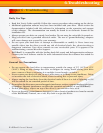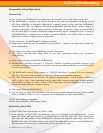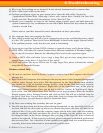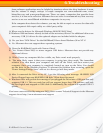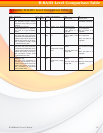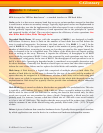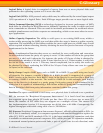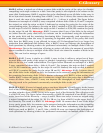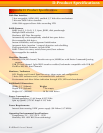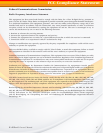
RAIDBank5 Owner’s Manual
43
RAID 3 utilizes a striped set of three or more disks with the parity of the strips (or chunks)
comprising each stripe written to a disk. Note that parity is not required to be written to the
same disk. Furthermore, RAID 3 requires data to be distributed across all disks in the array in
bit or byte-sized chunks. Assuming that a RAID 3 array has N drives, this ensures that when
data is read, the sum of the data-bandwidth of N – 1 drives is realized. The figure below
illustrates an example of a RAID 3 array comprised of three disks. Disks A, B and C comprise
the striped set with the strips on disk C dedicated to storing the parity for the strips of the
corresponding stripe. For instance, the strip on disk C marked as P(1A,1B) contains the parity
for the strips 1A and 1B. Similarly the strip on disk C marked as P(2A,2B) contains the parity
for the strips 2A and 2B. Advantage: RAID 3 ensures that if one of the disks in the striped
set (other than the parity disk) fails, its contents can be recalculated using the information
on the parity disk and the remaining functioning disks. Consequently read operations can
be time-consuming when the array is operating in degraded mode. If the parity disk itself
fails, then the RAID array is not affected in terms of I/O throughput but it no longer has
protection from additional disk failures. Also, a RAID 3 array can improve the throughput of
read operations by allowing reads to be performed concurrently on multiple disks in the set.
Disadvantage: Due to the restriction of having to write to all disks, the amount of actual disk
space consumed is always a multiple of the disks’ block size times the number of disks in the
array. This can lead to wastage of space.
RAID 5 A RAID 5 array is similar to a RAID 4 array in that, it utilizes a striped set of three
or more disks with parity of the strips (or chunks) comprising a stripe being assigned to the
disks in the set in a round robin fashion. The figure below illustrates an example of a RAID
5 array comprised of three disks – disks A, B and C. For instance, the strip on disk C marked
as P(1A,1B) contains the parity for the strips 1A and 1B. Similarly the strip on disk A marked
as P(2B,2C) contains the parity for the strips 2B and 2C. Advantage: RAID 5 ensures that if
one of the disks in the striped set fails, its contents can be extracted using the information on
the remaining functioning disks. It has a distinct advantage over RAID 4 when writing since
(unlike RAID 4 where the parity data is written to a single drive) the parity data is distributed
across all drives. Also, a RAID 5 array can improve the throughput of read operations by
allowing reads to be performed concurrently on multiple disks in the set.
RAID 10 A RAID 10 array is formed using a two-layer hierarchy of RAID types. At the lowest
level of the hierarchy are a set of RAID 1 arrays i.e., mirrored sets. These RAID 1 arrays in turn
are then striped to form a RAID 0 array at the upper level of the hierarchy. The collective result
is a RAID 10 array. The figure below demonstrates a RAID 10 comprised of two RAID 1 arrays
at the lower level of the hierarchy – arrays A and B. These two arrays in turn are striped using
4 stripes (comprised of the strips 1A, 1B, 2A, 2B etc.) to form a RAID 0 at the upper level of
the hierarchy. The result is a RAID 10. Advantage: RAID 10 ensures that if one of the disks
in any parity group fails, its contents can be extracted using the information on the remaining
functioning disks in its parity group. Thus it offers better data redundancy than the simple
RAID types such as RAID 1, 3, and 5. Also, a RAID 10 array can improve the throughput of
read operations by allowing reads to be performed concurrently on multiple disks in the set.
C-Glossary



